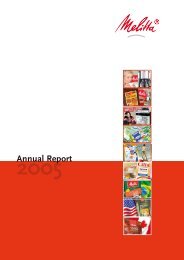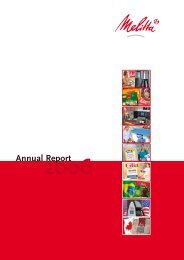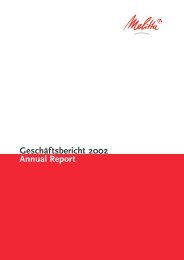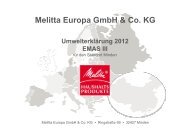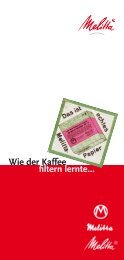You also want an ePaper? Increase the reach of your titles
YUMPU automatically turns print PDFs into web optimized ePapers that Google loves.
52 <strong>Melitta</strong> Group <strong>Annual</strong> <strong>Report</strong> <strong>2010</strong><br />
Debt was consolidated according to Sec. 303 (1) HGB,<br />
while income and expenditure were consolidated pursuant<br />
to Sec. 305 (1) HGB and unrealized results eliminated<br />
in accordance with Sec. 304 (1) HGB.<br />
Accounting and valuation principles<br />
Uniform valuation of assets throughout the Group is<br />
guaranteed by the application of corporate guidelines,<br />
valid for all members of the <strong>Melitta</strong> Group – with the<br />
exception of those companies consolidated using the<br />
equity method. These corporate guidelines correspond<br />
to commercial law regulations.<br />
Intangible assets are valued at cost, while property, plant<br />
and equipment are valued at acquisition or production<br />
cost; they are written down using the straight-line or<br />
diminishing balance method. In addition to direct costs,<br />
production costs also include a proportionate amount of<br />
overhead costs and depreciation. Financial assets are valued<br />
no higher than at acquisition cost, or the lower fair<br />
value. In the case of permanent impairment, fixed assets<br />
are subjected to non-scheduled depreciation.<br />
Inventories are valued at acquisition or production cost.<br />
Raw materials, supplies and merchandise are valued at<br />
the lower of average purchase prices and current values.<br />
Unfinished and finished goods are valued at production<br />
cost, which also includes a reasonable amount of necessary<br />
overhead cost and depreciation. Production costs<br />
are lowered accordingly, should this be necessary to<br />
avoid valuation losses. Suitable allowances are made to<br />
cover inventory risk.<br />
Advanced payments, accounts receivable, other assets<br />
and cash and cash equivalents are carried at their nominal<br />
values or the lower buying rate for foreign currencies<br />
and the lower rate in the case of recognizable risks.<br />
Lump-sum allowances have been made to cover general<br />
credit risks.<br />
Pursuant to Sec. 306 HGB, deferred tax assets and liabilities<br />
are formed for consolidation entries with an effect<br />
on income. Deferred tax assets were formed in accordance<br />
with Sec. 274 HGB for tax loss carryforwards for<br />
which it can be assumed with adequate probability that<br />
they will be used in future, as well as for temporary differences<br />
between the commercial and tax balance sheet,<br />
and were netted with deferred tax liabilities. For the<br />
measurement of deferred taxes, the individual tax rates<br />
of the parent company and the affiliated companies<br />
included in consolidation were considered. The option<br />
pursuant to Sec. 306 Sentence 6 HGB was utilized.<br />
Accruals for pensions are calculated using the projected<br />
unit credit method. Pension accruals are measured with<br />
an interest rate of 5.17 percent as at September 30, <strong>2010</strong>.<br />
There were no significant deviations between interest<br />
rates as at September 30, <strong>2010</strong> and as at December 31,<br />
<strong>2010</strong>. In accordance with the simplifying provision of Sec.<br />
253 (2) Sentence 2 HGB, a standard remaining term of 15<br />
years was assumed for the obligations. Future pay<br />
increases were taken into account at a rate of 3 percent<br />
p.a. Standard consideration throughout the Group was<br />
also given to the relevant biometric calculation basis<br />
(including the RT 2005 G mortality chart) and other calculation<br />
principles for the settlement amount to be used.<br />
Other accruals cover all recognizable risks and uncertain<br />
commitments in the amount of the respective settlement<br />
amount. Accruals with maturities of over one year<br />
were measured in accordance with Sec. 253 (2) HGB.<br />
Subject to the fulfillment of the corresponding prerequisites,<br />
transactions expected with a high level of probability<br />
(hedged items) are placed together with derivative<br />
financial instruments in hedging relationships in order<br />
to balance contrasting value changes or cash flows from<br />
the acceptance of comparable risks. Such hedging relationships<br />
are presented in the financial statements using<br />
the net hedge presentation method.



